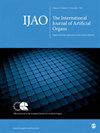腰椎融合术后医源性肌肉韧带复合损伤对邻近节段的生物力学影响:有限元分析。
IF 1.4
4区 医学
Q4 ENGINEERING, BIOMEDICAL
International Journal of Artificial Organs
Pub Date : 2023-10-01
Epub Date: 2023-10-21
DOI:10.1177/03913988231203586
引用次数: 0
摘要
目的:应用有限元分析方法分析腰椎融合术(PLIF)后近端医源性肌肉韧带复合体(MLC)损伤对邻近节段的生物力学影响。方法:在经验证的完整腰骶部有限元模型中加载多裂肌力量。根据是否接受PLIF或MLC近端损伤,建立了三个模型。分析了相邻节段的运动范围(ROM)和最大von Mises(VM)应力,以及四个加载方向上的平均肌肉力量和工作能力。结果:PLIF导致ROM和应力的显著变化。ROM在上部相邻节段发生了显著变化,PLIF模型在扩展中变化最大,下部相邻节段的最大变化发生在MLC损伤后。上相邻节段的VM应力发生在PLIF模型的扩展中,下相邻节段发生在MLC损伤后的旋转中。与正常和PLIF模型相比,受损MLC融合模型的屈曲、ROM和应力显著增加,并存在逐步放大。三种模型的平均肌肉力量比较分别为5.8530、12.3185和13.4670 N、 分别。总工作能力的比较接近于肌肉力量的比较。结论:PLIF导致邻近节段的ROM和VM应力增加,近端MLC损伤会加剧这种变化。这可能会增加ASD和慢性腰痛的风险。保留近端MLC可减少对相邻节段的生物力学影响。本文章由计算机程序翻译,如有差异,请以英文原文为准。
Biomechanical effects of iatrogenic muscle-ligaments complex damage on adjacent segments following posterior lumbar interbody fusion: A finite element analysis.
Objective: To analyze the biomechanical effects of proximal iatrogenic muscle-ligaments complex (MLC) damage on adjacent segments following posterior lumbar interbody fusion (PLIF) by finite element (FE) analysis. Methods: The multifidus muscle force was loaded in the validated intact lumbosacral finite element model. Based on whether undergoing PLIF or the proximal MLC damage, three models were established. Range of motion (ROM) and the maximum von Mises (VM) stress of adjacent segments were analyzed, as well as the average muscle force and work capacity in four loading directions. Results: PLIF results in significant changes in ROM and stress. ROM changed significantly in the upper adjacent segment, the PLIF model changed the most in extension, and the largest change in the lower adjacent segment occurred after MLC damage. The VM stress of the upper adjacent segment occurred in extension of the PLIF model, and that of the lower adjacent segment occurred in rotation after MLC damage. In flexion, ROM, and stress of the damaged MLC fusion model were significantly increased compared with the normal and PLIF models, there was a stepwise amplification. The average muscle force comparison of three models was 5.8530, 12.3185, and 13.4670 N, respectively. The total work capacity comparison was close to that of muscle force. Conclusion: PLIF results in increased ROM and the VM stress of adjacent segments, the proximal MLC damage will aggravate this change. This may increase the risk of ASD and chronic low back pain. Preserving the proximal MLC reduces the biomechanical effects on adjacent segments.
求助全文
通过发布文献求助,成功后即可免费获取论文全文。
去求助
来源期刊

International Journal of Artificial Organs
医学-工程:生物医学
CiteScore
3.40
自引率
5.90%
发文量
92
审稿时长
3 months
期刊介绍:
The International Journal of Artificial Organs (IJAO) publishes peer-reviewed research and clinical, experimental and theoretical, contributions to the field of artificial, bioartificial and tissue-engineered organs. The mission of the IJAO is to foster the development and optimization of artificial, bioartificial and tissue-engineered organs, for implantation or use in procedures, to treat functional deficits of all human tissues and organs.
 求助内容:
求助内容: 应助结果提醒方式:
应助结果提醒方式:


